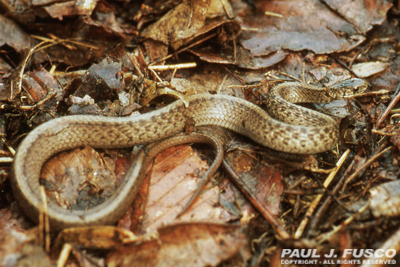Dekay's Brownsnake
Storeria dekayi dekayi

Background and Range: The Dekay's brownsnake is found throughout Connecticut, and its population is currently considered secure in the state. This common but secretive snake flourishes in developed and urban areas. It has also been known as the northern brownsnake.
The species is widely distributed over most of the northeastern United States and adjacent Canada, from southwestern Maine through Pennsylvania south to North Carolina.
Description: This small snake usually reaches an adult length of 9 to 15 inches. It has keeled scales (raised ridge along the center of each scale), and a dorsum (back) that ranges from dark brown or light tan in coloration. Two rows of darker spots run along the length of the back, often with a lighter band running between the darker rows. Irregular banding or weakly diamond-shaped patterns can also be found on the back. The belly is gray to pink and can have small black spots along the edges. A black mark is behind each eye and on the neck. Young Dekay's brownsnakes can be identified by their white neck-ring, lack of spots, and darker body.
Habitat and Diet: Dekay's brownsnakes are found in a variety of habitats, such as wetlands, grasslands, and forests, but they are most commonly encountered in disturbed or residential areas. Populations are most abundant in more developed portions of the state, even in vacant lots in some of Connecticut's largest cities. In forested areas of the state, these snakes are more localized, and often restricted to small patches of disturbance, such as along roadways, railroad tracks, or edges of fields.
This snake feeds during all hours of the day on insects, earthworms, slugs, snails, fish, and small amphibians (rarely).
Life History: In southern New England, Dekay's brownsnakes are active from March through November. Once they emerge from their winter dens in spring, they immediately begin to look for a mate. The mating season in New England extends from March to May. Beginning in mid-July through August, females give birth to live young (viviparous) after a 105 to 113-day gestation period. Litter sizes range from 3 to 31 young snakes, which measure about 3.5 inches. The young tend to stay near the female shortly after birth, but she does not take care of them, and they must fend for themselves.
Interesting Facts: Dekay's brownsnakes are somewhat tolerant of colder temperatures. They spend the winter in dens, such as rodent burrows, rock crevices, or under buildings, that are below the frost line. These winter dens are often communally shared with other brownsnakes and also with other snake species, like gartersnakes, northern redbelly snakes, and smooth greensnakes.
These secretive snakes prefer to hide under rocks, logs, old boards, and other similar debris. They are normally active during the day; however, if daytime temperatures are too hot, the snakes will become nocturnal. This harmless snake is non-venomous and does not bite. If handled or provoked, it can produce a strong musk odor from its anal glands. This reaction is rare and only used as a last resort.
Dekay's brownsnakes are often confused with northern redbelly snakes, which can be slightly smaller and have a brown or gray body with a bright red or orange belly and keeled scales (raised ridge in the center of each scale). Redbelly snakes are more widespread in forested areas, whereas brownsnakes are usually found in disturbed habitats.
The Dekay's brownsnake may expand its range and increase in population density throughout southern New England as rural areas become increasingly urbanized and snake species less tolerant of urban habitats decline.
Snakes and People
Take the time to learn about, understand, and respect this vitally important reptile, and share your knowledge with others. If you encounter a Dekay's brownsnake, observe it from a distance, and allow it to go on its way. All snakes will retreat from humans if given a chance.
Even though a brownsnake may not bite, you should try not to disturb it by getting too close or handling it. Its only defense is the release of musk from special glands when disturbed. Brownsnakes, or any other wild snake, should NEVER be collected as a pet, and the killing of snakes is strongly discouraged.
To discourage snakes from entering buildings, make sure all cracks in the foundation are sealed. Basement windows should be closed tight or be covered with screens. If you wish to discourage snakes from your yard, remove the places where they can hide. Keep grass cut short, remove brush and rock piles, and keep shrubs trimmed up off the ground. These methods will discourage snake prey species from the yard as well.
If you encounter a snake problem, assistance and more information about snakes can be found by visiting the Snakes in Connecticut webpage or calling the DEEP Wildlife Division at 860-424-3011.
Amphibians and Reptiles of Connecticut and Adjacent Regions, by Michael W. Klemens (1993), was used as reference for this fact sheet.
Content last updated on August 15, 2022.

